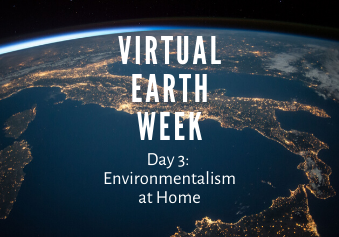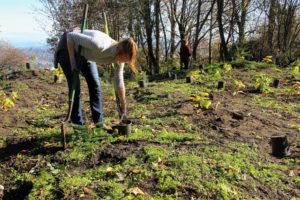Virtual Earth Week, Part 3: Environmentalism at Home
Today is the 50th anniversary of Earth Day, which, due to shelter-at-home restrictions, we are unfortunately unable to celebrate with a volunteer event. Instead, we have put together this 5-part blog series, releasing a new post each day of Earth Week. DNDA has also launched a new video series about environmentally friendly cooking on our YouTube channel, and we will be drawing a winner from our Earth Day giveaway on Friday, April 24. Stay safe, stay healthy, and join us in celebrating Earth Week from home!

- Turn off your electronic devices and unplug non-essential appliances for one hour (or the entire day, if you’re looking for an extra challenge). Use this time to indulge in some offline hobbies: read, knit, go for a walk, hit the gym, draw, paint or make art, spend some time in the garden, or make music!
- Participate in an online climate strike. Earth Day Live is hosting three days of online striking from April 22-24, where they’ll be hosting teach-ins, musical and art performances and more.
- Calculate your carbon footprint. Whether examining your personal footprint or your household’s, there are many steps you can take to reduce your greenhouse gas emissions and make the planet a healthier place to live. Find your footprint here, write down goals to reduce it, and document the steps you take to achieve your goals.
- Purchase carbon offsets. Transitioning from carbon-costly lifestyle choices to low-emission alternatives may be more challenging than expected. If you have dietary restrictions or health concerns, a vegan diet might not be the right option for you. If you need to take transatlantic flights to visit your family, emissions from jet fuel pollution may leave you feeling guilty. You can help counterbalance your less eco-friendly decisions by buying carbon offsets. Many airlines offer carbon calculators which calculate the amount of carbon emitted on flights you take, and tell you how many trees need to be planted to offset these emissions. You can then purchase offsets directly from the airline to plant your trees. While this may not make your trip entirely carbon neutral, it will make an impact on lowering your carbon footprint. For a comprehensive list of where to purchase offsets, visit this guide by EcoLife.
Opt out of junk mail subscriptions. Roughly 4 million tons of junk mail is generated in America each year, and the majority of it winds up in landfills. Do your part in reducing waste from your mail by directly contacting companies who send you spam and asking them to remove you from their mailing list.
- Donate to tribes, nonprofits and other environmental organizations. With the spread of coronavirus, many organizations have had to stop or reduce environmental programs such as restoration projects, community education or animal conservation, to name a few. Consider helping them stay afloat by donating to support their causes. As the original stewards of the lands we stand on, tribal nations play a crucial role in protecting the natural environment. Use this interactive map to learn which tribe’s territories you are in, and contact those nations to learn more about how you can help. You can also consider contributing to DNDA, The Nature Conservancy, EarthCorps, or any local, national or international cause that speaks to you.
- Do an easy, DIY arts & crafts project with your kids. Pinterest has no shortage of great ideas for teaching kids about environmental stewardship in a fun and engaging way! Nurture your creative side by making a collage, melting some crayons, printing off blank coloring pages, making art from shaving cream, or drawing a planet handprint. For kids more interested in science and construction, do a Magic Milk experiment (use blue and green food dye to make it look like Earth), build a bug hotel, start an indoor compost bin, grow veggies from food scraps, model an oil spill cleanup, or send them on a backyard scavenger hunt.
- Go outside! This is a tricky item in our current era, but in our opinion, the best way to experience nature is to head outside and appreciate all that it does for us. Leave your phone at home and take a little trip to soak up all the beauty Mother Earth has to offer. In order to do this in a safe manner for yourself and the community, please wear a mask, maintain your distancing from others and keep moving! If you’re interested in taking one step further in deepening your connection to the environment, check out our guide to forest bathing.
Stay tuned for the rest of this week’s Virtual Earth Day blog post series! We’ll be posting a mini blog post each day during Earth Week to inspire you to take virtual action for your planet. We’re also hosting an Earth Day Giveaway for a chance to win an Earth Day gift box with reusable kitchen and home products. To enter, make an environmental pledge by April 24th, 5:00 PM PST: the winner will be announced the next day!

 Opt out of junk mail subscriptions. Roughly
Opt out of junk mail subscriptions. Roughly 